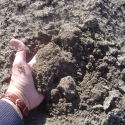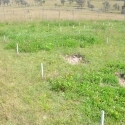29 Jan 2019
Foliar Fertilizers
Is the foliage the RIGHT place to apply plant nutrients?
 Water drop sitting on a wheat leaf
Water drop sitting on a wheat leaf
Placing plant nutrients in or on the soil faces all the challenges of immobilization, leaching, volatilization and other loss processes. Improving nutrient use efficiency by applying plant nutrients directly onto the foliar is an attractive, potentially environmentally friendly and increasingly popular strategy. It is certain that many plant nutrients can be taken up either through the leaf cuticle or the stomata but a detailed understanding of the leaf physiology, the chemical nature of the nutrient applied and the environmental conditions are all important in achieving a crop yield response. While the crop canopy is a good place to apply nutrients, the source and timing are also critically important. Not all nutrients are equally effective as foliar fertilizers mainly because of the amounts required to overcome a nutrient deficiency.
Macronutrients such as nitrogen and potassium are routinely applied as foliar fertilizers although the amounts taken up can be relatively small compared to the total nutrient demand. Research in Australia has shown that current foliar phosphorus formulations are not effective at providing supplementary phosphorus to give yield responses in wheat. Micronutrients such as zinc, manganese and copper are also commonly applied as various salts, or with a range of adjuvants to improve uptake and efficiency. Even so, timing of application to meet critical periods of demand is also important. The range of biological and chemical adjuvants proposed for use with foliar nutrients is a growing area, but there is little information from well-designed field experiments to assess their impact on yield.
The decisions by growers about selecting the right nutrient sources for foliar application is as critical as selecting the right time and right rate.
Additional Resources
Slides from the presentationSize: 7.37 MB




